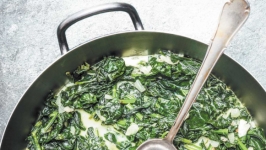What’s in Season: Spinach
Spinach is thought by most botanists to have originated in Persia, modern day Iran. From there, the wild plant’s evolution into what we now refer to as spinach was not a linear one, leading to the development of several distinct varieties we find today.
The puckered, pillowy Savoy and Semi-Savoy types have thick leaves and stems with substantial texture and intense, mineral-forward flavor. The smooth-leafed types have thin, almost negligible stems and are often harvested young. When very young, this type is sold as loose-leafed “baby spinach,” and when left to grow into adolescence, most often sold gathered into plump bunches. Its flavor is quite mild compared to its close cousins Savoy and Semi-Savoy spinach.
These diverse types of spinach lend themselves to different culinary treatments.
Savoy and Semi-Savoy, sometimes called fall or winter spinach, are the types commonly found in the markets of France and Italy and in farmers’ markets in our own region, too, during the cold months. Dark green leaves are piled high and sold by the kilo or pound, destined for such comfort dishes as creamed spinach and spinach gratins. These preparations make sense because the leaves are sturdy, sometimes even tough. Very often you need to remove their fibrous stems and thick ribs before cooking. The best way to do this, according to Julia Child in her Mastering the Art of French Cooking, is “For more mature spinach, fold the leaf vertically, its underside up, in the fingers of one hand; grasp the stem in the other hand and rip it off toward the tip of the leaf, thus removing with the stem the tough tendrils which are attached to the underside of the leaf.”
On the other hand, smooth-leafed spinach is typically so tender and succulent it’s best eaten raw, made into salads or—at most—wilted and served as a bed for salmon, for example, or added at the last minute to top a pizza. This delicate type doesn’t hold up well when cooked and tends to lose both flavor and texture.
In our area, smooth-leafed spinach is found year-round in supermarkets. While the Savoy type is commercially cultivated in California’s Central Valley, it is not nearly as ubiquitous as the smooth-leafed. The heartier spinach is found mostly at farmers’ markets, especially in fall and winter. I encourage you to give it a try, even if it takes an extra step or two to prep, and requires a longer cooking time. One of my family’s favorite ways of enjoying this flavorful leafy green, chock full of vitamins A, C and K, and iron, folate and manganese, among other minerals, is creamed, which may just be the ultimate comfort food.






